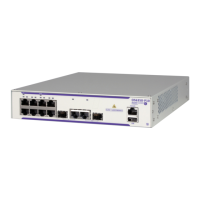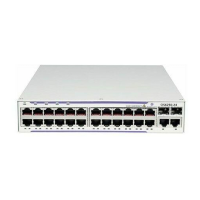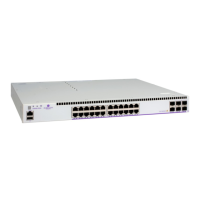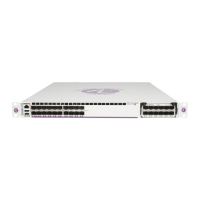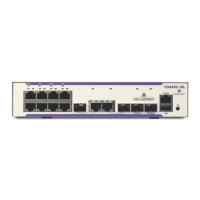Configuring Multiple VRF Multiple VRF Overview
OmniSwitch AOS Release 8 Network Configuration Guide December 2017 page 16-8
VRF Profiles
The VRF feature supports two types of VRF instances: a low profile instance and a max profile instance.
The type of profile assigned to a VRF instance determines the routing protocols and capabilities supported
within that instance.
• Low profile VRFs only support IPv4 and VRRP, with routing capabilities restricted to static and
imported routes. In addition, limiting low profiles to 9 routes and 3 IP interfaces is highly
recommended.
• Max profile VRFs support full VRF routing capabilities and limits.
The type of profile applied is determined at the time the VRF instance is created. The default VRF
instance uses the max profile capabilities; configuring the default VRF profile is not allowed.
Using low profile VRFs gives an administrator the ability to create VRFs with minor routing capabilities
and complexity. Low profiles take up less switch resources than max profiles, which allows for creating
more VRFs on the switch.
The ability to create many low profile VRFs is particularly useful in cases where all traffic only flows
through a handful of individual routes to reach specific destinations; the administrator can separate many
network access points into VRFs. For example: in a building there may be many tenants that need to reach
several end stations and one or two WAN access points through a shared core network. Each private
network needs its own address space, but does not need a routing protocol to share many routes (may only
need a default route).
A combination of low and max profiles is allowed on the switch. However, the total number of VRFs
allowed on the switch may differ depending on the availability of switch resources and the number of low
and max profile VRFs configured.
Using the VRF Command Line Interface
The Multiple VRF feature uses a context-based command line interface (CLI). When the switch boots up,
the default VRF instance is automatically created and active. Any commands subsequently entered apply
to this default instance. If a different VRF instance is selected, then all subsequent commands apply to that
instance.
The CLI command prompt indicates which instance is the active VRF context; the instance name is added
as a prefix to the command prompt. For example, if VRF instance IpOne is the current context, then IpOne
appears in the CLI command prompt. For example:
IpOne: ->
When the default VRF instance is the active context, no VRF name appears in the command prompt. For
example, the following prompt indicates that the default VRF instance is the current context:
->
It is also possible to enter configuration commands for other non-default instances from within the default
VRF CLI context. For more information about how to do this and additional examples of using the VRF
Note. Only those commands for features that are VRF aware are accepted within the context of a VRF
instance. Default VRF applications are supported only in the default VRF instance. For more information
about VRF supported applications, see “VRF Interaction With Other Features” on page 16-11.

